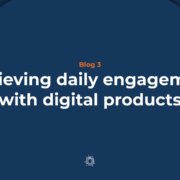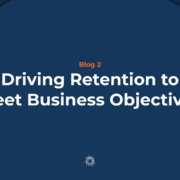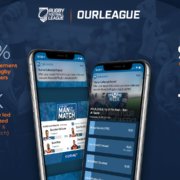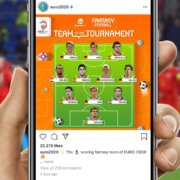In the previous blog we reviewed how gamification techniques could be applied to our digital products. From now on, we’re going to look at specific example case studies of techniques used across a variety of industries in the digital space and delve into the reasonings and outcomes of using them. We’ll also look at applying these techniques to users of apps and websites in a sports contexts to create great digital experiences for fans. In this blog, #2 in the series, we will be taking a closer look at a gamification technique which will enhance fans’ digital experiences whilst delivering on targeted business objectives.
Gamification technique #1: setting personal goals and challenges
The first gamification principle we will cover in this series is the setting of personal goals or objectives. Our aim in this topic of gamification is to bring users back to a product more frequently than they would otherwise do and reward them for coming back, consequently extending the average usage lifespan and frequency of engagement.
The technique of setting “personal goals and challenges” is highly versatile and revolves around the idea of presenting users with a series of small tasks.
The user is given a reward for completing certain tasks and is able to track how many they have completed. Tasks can directly relate to business objectives; for example, in the case of a football club, selling more merchandise. An example task in this case might be “Purchase an item of merchandise from the club shop”, from which we can then reward the user with a discount on their next purchase.
The tasks get progressively harder and require more time and effort to complete. They usually relate to the use of main features of the product across different scenarios. Once a user completes a task, the next one appears and there’s often a choice of several different tasks to complete at any one time.
With this technique, rights holders can turn a series of relatively standard points of contact with the fans into a fun, interactive game in which participants can win prizes and earn social recognition.
The benefits
The implementation of this technique offers a number of benefits. To start with, the user is shown how they can earn rewards by using the digital product; this is a clear, obvious value exchange between the user and the app supplier (namely: “Do this, earn that”), providing more incentive to use a digital service.
Rewards don’t have to be physical prizes, they can be digital ones like discount codes or a digital badge to certify that the user completed the task. The latter provides official and social recognition and taps into the innate human desire to collect things (programmes, ticket stubs, club shirts etc) and boast about it over social media and other channels.
Secondly, this technique directly targets our aim to increase retention on the digital platform, as we are asking the user to participate in tasks which explicitly require progressively more time and effort to complete. We have the power to tailor the requirements for fulfilling each personal goal to help return usage and retention, like setting a task to be be completed over a number of days (weeks, months etc), or by requiring a certain action to be performed a certain number of times.
By slowly increasing the effort involved in tasks, the user is eased into having more contact with the product instead of throwing them straight in at the deep end.
Essentially this aims to help a new first-time user become a highly engaged user much quicker and with greater likelihood. The non-linear scale of progression further means that the user is rewarded, albeit in a smaller way, more frequently during the most critical period of use (during their first few days/weeks using the product), but can still be rewarded (perhaps with bigger rewards) later on.Small victories are very important for the user in building positive association with a product.
Thirdly, this technique helps the product to become more sticky; harder for the user to forget about and uninstall.
This is because they will have built up perceived value in the platform; a knowledge that they have put time and effort into progressing through the tasks to reach a certain point. If they uninstall now they won’t stand a chance of earning the next reward. There can also be considerable personal and social prestige in having put so much effort in. It’s something to be proud of or brag about and show off to friends. It becomes a challenge or game to try and complete the hardest tasks. Repetitive tasks which require regular interaction (e.g. every day) are then brought to the forefront of users’ minds, and can even lead to the app being dropped into casual conversation among friends or colleagues. One can imagine a conversation between friends who all use the same app saying “Oh I managed to complete that task over the weekend”, “No way, really?? That must have taken you forever!”. Take the daily HQ Trivia quiz app that was popular in 2018; we frequently played and discussed our progress in the InCrowd office!
Finally, and perhaps most importantly in regards to ROI, we can write tasks which are derived directly from business objectives. We offer fans a value exchange in a similar way to a loyalty scheme (which, incidentally, I would argue is also a form of gamification).
As a side note, this process can also be used to help new users of a product by providing tasks which help to guide the user through basic functionality. In essence adapting this feature to act as a tutorial or guide, further reinforces positive outcomes early on in the user’s experience.
Case study: Call of Duty
Let’s take a look at this technique in action.
For our first case study in this series we will turn to the video games industry and to the current iteration of one of the most popular games of all time; Call of Duty: Modern Warfare (MW). MW makes use of setting personal goals in a couple of key ways…

Members of the InCrowd Call of Duty squad preparing for the start of a match! Screenshot: Call of Duty: Modern Warfare “Warzone” on PC, captured using NVIDIA GeForce Experience.
The multiplayer portion of MW has a number of weapons for the user to use in battle. Each weapon has a collection of attachment upgrades used to fine-tune the performance of the weapon for different scenarios and to the user’s preferences. However, these attachments are earned slowly over time as the user uses each weapon more and more. Some of the best and most frequently used attachments are earned last, requiring the most amount of time and effort to acquire. Furthermore, not all weapons are available to use when the user first plays the game; they are required to complete very specific challenges to ‘unlock’ them. The net result is that if you want the freedom to access and use any weapon and attachment configuration of your choice, you must first prove your worth by taking the time to complete the associated challenges.
Moreover, MW offers users the ability to apply a camouflage to their weapons – with designs ranging from mundane and bland to exciting and colourful. Each camo is associated with a certain type of challenge requiring that the weapon be used in all manner of different specific situations. Some challenges are very straight forward to complete, yet require progressively more time to unlock. Other challenges are much more challenging to complete! The best, most visually engaging camos are the hardest to unlock and require a considerable amount of dedication to acquire. It’s very easy to spot a seasoned player in a game of Call of Duty: Modern Warfare!
The developers of MW have even gone so far as to add a special Golden camo which is earned for unlocking all of the others; this is a true accolade to earn. But it doesn’t stop there; at the time of writing there are three additional camos earned for going above and beyond that, including one for unlocking the gold camo for ALL weapons – a massive feat!

Yes, that is my golden crossbow which I’m showing off to you. One of the hardest weapons to use in the game, this exemplifies every aspect of this gamification technique from increased retention to perceived value. Screenshot: Call of Duty: Modern Warfare on PC, captured using NVIDIA GeForce Experience
Furthermore, every day, users are given a fresh set of “Daily Challenges” to complete, often with some form of digital in-game reward. This keeps the game interesting and gets players checking back every day to see what’s up for grabs. There is always something new to entice players, reinforcing a habit of checking the challenges regularly.
These examples show how such a gamification technique can be constantly evolved as users complete more challenges.
The possibilities are pretty endless, especially if they are focussed on achievements; humans innately want to be bigger and better than their counterparts!
Rewarding time and effort
So to recap: the game presents a challenge in earning weapons, attachments and camos. The user must spend time slowly acquiring these as they play. Camos allow players to show off their skill with their favourite weapons and represent the effort which has been put in to earn them.
This simple process carries out two main jobs:
(1) it directly drives the levels of usage which the owner desires by demanding time and effort from the user. (2) It builds perceived value in what the user is earning through dedication and skill.
Neither of these statements would be true if everything was available to use (“unlocked”) from the beginning. The effort required, and the ‘glory’ of earning a golden camo results in users coming back to play more frequently, perhaps using free time which they would not otherwise have occupied with playing the game (something I know I am guilty of!).
Infinity Ward and Activision (the principle developers and publishers of Call of Duty: Modern Warfare respectively) use this method to drive the engagement statistics which they require to make the game a success. If they did not use this approach, users would only play when they are naturally inclined to do so through stimuli external to the game itself, such as a friend suggesting to play or finding some free time on a weekend.
However, MW ensures that the glory of earning a highly prized camo is always on the minds of its users, relying less on natural prompts to play and instead generating its own. The lure of a shiny golden weapon is too hard to resist to fans of the game… this results in more frequent prompts to play whenever a free moment arises, tapping into the human instinct to want to reap the rewards of their hard earned efforts.
The concept works particularly well because it presents a clear value proposition to users: “Put in the effort, and we will reward you”. Looking at this from the business point of view, this translates to “Use our product as frequently as we would like, and we’ll add more value to your experience”.
It’s fascinating that the reward doesn’t even need to be physical. In this instance, the user receives a digital reward, something to allow them to show-off to their friends and rivals in-game, and give them a more ‘complete’ experience… and being digital, it doesn’t cost much (if anything) to reward them. Digital rewards can be duplicated to match the requirement (almost) completely free.

A selection of camo options available to customise weapons in Call of Duty Modern Warfare. Screenshot: Call of Duty: Modern Warfare on PC, captured using NVIDIA GeForce Experience
Application in digital products for sports
We can take the fundamental elements of this technique and apply them to almost any digital product. Consider a football club. They want to sell more tickets, increase purchases at their club shop, encourage fans to eat and drink at the concession stands and get fans more engaged with the club.
Through their digital platforms, the club can release a series of challenges and rewards to celebrate fans who go the extra mile. This could be surfaced on their app or website for users to keep track of their progress.
“Challenges” could include:
- Visit the home ground once this season
- Buy a ticket for you and one other person
- Check the full time scores via the app for every match during the season
- Make a purchase at the club shop this season
- Purchase a drink at the bar on 3 separate occasions this season
- Read the club history page on the club website
…and more.
You’ll notice that these example challenges involve different areas; ticket sales to food and drink to digital platform usage, and each clearly address a business objective. Challenges are a great way to join the dots between different business areas and assets which the fans consider integral to their experience as a supporter. This can further help fans of all manner of backgrounds and circumstances be part of (and feel closer to) the club by carefully designing challenges which all fans can participate in and benefit from.
As part of the value exchange, via the chosen digital platform the club can give fans a fun personalised graphic which they can share to their social media or chat messages to show how far they’ve progressed. In combination with the rewarding of digital “achievement” badges, this gives fans social recognition for their achievement and feels a sense of appreciation from the club for their commitment.
The club could also give away rewards such as discounts on merchandise, a free drink at the bar or recognition via club social channels, all helping to communicate the value exchange and drive the targeted engagement. Rewards would need to be proportional to the effort required and budget available.
Additionally, a form of loyalty scheme can be used to reward users according to the number of challenges they’ve completed. The more challenges completed, the better the benefits from the scheme, with distinct tiers differentiating users according to the effort they have put in.
As you can see, this is a fun, rewarding way for fans to engage more with the club, while the club benefits from increased engagement in the particular areas targeted as per their business objectives.
It’s up to the club how to reward fans, be that digitally or physically. Provided that the user is given something to show for their effort, the value exchange remains intact.
The majority of us are naturally drawn to completing tasks – we never want to leave things half completed and we want to tick boxes – driven by the satisfaction of completing a task. The reward (no matter how small) exploits that piece of human nature and gives us an extra incentive;
“If I just play a bit more, I’ll unlock this item”.
“If I spend an hour extra cycling today, I’ll get to the top of the leaderboard”. “Only two more holidays and we’ll be gold members”.
All of this gives the user additional reason to consider doing something. In their mind it builds a case for (rather than a case against) using the digital product. In this way it becomes a prompt – something which the user takes into account when making decisions, such as whether to bother picking up their phone to open an app, or which holiday package provider to go with.
Increased revenue and new inventory to sell
Application of this technique aims to ultimately lead to increased revenue. By incentivising fans to use the club app and website more often and with greater engagement, the increased usage traffic allows you to serve sponsor adverts to fans more frequently, leading to greater sponsorship revenue and a higher demand for your premium digital advertising spots.
The concept as a whole generates new inventory to sell and opens up great new opportunities for brands to build a closer, more meaningful relationship with fans.
Brands can ‘own’ the rights to sponsor everything from the name + branding of the challenges, to providing the prizes and featuring on the shareable personalised graphics.
We often put our hopes and ambitions at the forefront of our thinking on a daily basis, never quite able to escape thinking about them every now and then. Helping users to complete personal achievements through digital products keeps the product in-mind and relevant, helping to ensure users regularly spend time interacting with it, rather than forgetting about it.
Additional case studies
This same concept is used in a plethora of different products. Avios reward passengers for frequent flying, giving them access to progressively better and better rewards with a clear progression system and visual prestige of being a gold member. Strava encourages greater use of their app by setting exercise challenges which users can opt-in to in order to earn badges. The Trainline also rewards fans with badges for choosing to book their tickets through them rather than competitors
All are examples of the gamification of physical “real life” processes applied to a digital world, intended to drive more frequent, longer term engagement from their customers.
Next week:
This week we’ve covered how to achieve audience retention; next week we’ll be diving into how we can drive regular daily engagement. We’ll take a look at DuoLingo, a leading language learning app which encourages its users to complete lessons everyday, following its gamified approach to education. We’ll see how similar principles can be used to increase engagement levels among fans on match days.












 85,000+ interactions with Our Leagues polls, predictor and player of the match vote.
85,000+ interactions with Our Leagues polls, predictor and player of the match vote.







